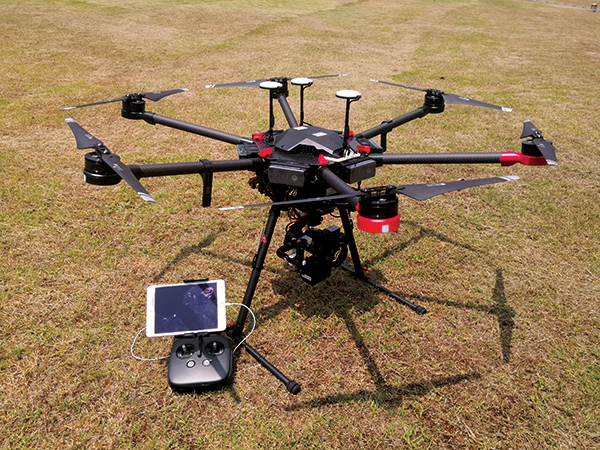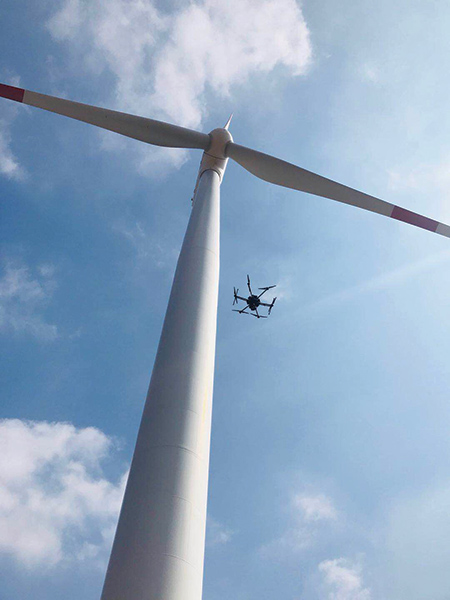The wind energy industry is growing rapidly. In the U.S. alone, the wind industry invested more than $11 billion in new plants in 2017 and added more than 7,000 megawatts of new capacity, representing a full 25 percent of all electric capacity additions across the energy industry last year. Today, wind energy contributes more than six percent of the nation’s electricity supply, more than 10 percent of total electricity generation in fourteen states, and more than 30 percent in four of those states. However, as with other renewable energies, the wind power industry still faces many obstacles. One of the biggest challenges to growth remains the high costs of constructing wind farms, as well as the ongoing operations and maintenance costs. The industry also still relies heavily on government subsidies and federal tax incentives, which can be unreliable and phased out, depending on whichever way the “winds” of the current political climate are blowing.
To further its growth, reduce costs and increase profitability, the wind power industry is increasingly turning to emerging technologies such as artificial intelligence (AI), machine learning (ML), edge computing and Internet of Things (IoT) sensors and devices, such as autonomous drones. These technologies are being combined in new and innovative ways to help wind farms automate costly and time-intensive operational tasks such as turbine inspections and are delivering real-time data insights to help wind farms lower operational costs and improve efficiency for greater profitability.

Challenges Facing the Wind Power Industry
The need to lower operations and maintenance (O&M) costs remains a persistent challenge in the wind power industry, especially as turbines age. According to analysts, O&M costs average between $42,000 and $48,000 per megawatt during the first 10 years of a turbine’s operations, and wind farm owners are expected to spend more than $40 billion on O&M over the next 10 years.
One reason O&M costs remain high is due to the conditions in which wind turbines operate. The tip of an average wind turbine blade rotates at a speed of 300 km per hour (more than 180 miles per hour). That’s the speed of a bullet train, running 24 hours a day while exposed to the harsh conditions of driving wind, rain, hail, dirt and other particles. Faced with this environment, turbine blades degrade rapidly, which can reduce a wind farm’s output by 12 percent over a 20-year lifetime and increase the cost of electricity by nine percent. It’s no wonder that lowering O&M costs is top of mind for every wind farm owner and operator. Fortunately, new digital technologies can help wind farms lower these costs while boosting performance, increasing operational efficiency and extending the life of turbines. Here are just a few examples:
“Talking” Turbines Powered by IoT
Today’s wind turbines are increasingly equipped with hun¬dreds of IoT-connected sensors, enabling them to “talk” to wind farm operators and provide greater visibility into operations. These sensors can continually measure every aspect of wind turbine operations such as acceler¬ation, temperature, vibration, environmental conditions, sounds that could indicate a problem with the turbine and more. AI and data analysis are applied to sensor data to identify problems and suggest actions that can improve performance and increase productivity. For example, to produce the most electricity, turbines need to be turned toward the wind, but it takes a significant amount of time and energy to turn the direction of the blades. By using AI and advanced algorithms, operators can better predict wind intensity, direction and angle, in order to turn blades in advance of changes in weather conditions. One turbine manufacturer in China has been able to help its custom¬ers boost energy production by 15 percent by using tur¬bine sensor data to optimize the angle and speed of their blades based on environmental conditions.
With the growing prevalence of IoT sensors and data, wind farms are beginning to build networks where they can monitor nearly every aspect of operations in order to increase energy production and better manage the condition of equipment over its lifetime. However, one area where many still struggle to gain significant improvements has been in the time- and labor-intensive task of visual turbine inspections – but that is beginning to change.
Automating Visual Inspections with Drones and AI
Though many turbines today are equipped with a variety of IoT sensors measuring vibrations, sounds and more, wind farm operators still need greater – and earlier – visibility into the condition of blades. For instance, by the time a turbine has degraded to the point where it is vibrating or creating an unusual noise, the damage is already severe. Regular visual inspections of blades are needed to identify cracks or other blade damage that can be fixed with a simple patch while still small. However, if an operator is not alerted to a problem until the blade is vibrating or whistling, they will likely need to shut down the turbine and replace the entire blade. This can cost the operation hundreds of thousands of dollars, as they will need to purchase new blades, bring in heavy equipment to hoist them up, and spend many labor hours installing them – not to mention the cost of downtime as the turbine may be turned off and not producing electricity for weeks or months as they wait for the new blades arrive and be installed. Clearly, having greater visibility into blade conditions in order to minimize the need for repairs and downtime is a highly-sought after advantage that can save wind farms a tremendous amount of time and money.
This is where emerging technologies such as autonomous drones equipped with AI, ML and advanced computer vision are making a dramatic impact. Traditionally, visual inspections required shutting down a turbine and, sending one or more highly trained technicians up the tower, on ropes, to inspect the blades. A typical inspection could take six to eight hours per turbine. However, by using autonomous drones for visual inspections, wind farm operators can complete turbine inspections in as little as 15 minutes.
With essentially the click of a button, the autonomous drone can fly itself up the turbine, conduct a detailed, visual inspection and then land itself without the need for a human pilot. Wind farms first began experimenting with using drones for inspections several years ago, but those had to be manually piloted and required two highly trained operators: one to fly the drone without colliding into the turbine and the other to take photos of the blades. With today’s autonomous drones, only one operator is required, and that person needs only minimal training. The drone launches itself and, using built-in sensors and AI, closely tracks a precise path along each blade. Precision photography and advanced computer vision are used to identify automatically and flag defects such as hairline cracks or chips as small as one millimeter by three millimeters – better than the human eye can. In fact, autonomous drones are so precise, they have even been known to photograph and identify a common fly resting on a blade during an inspection! Built-in machine learning automatically stitches together thousands of photographs to give operators a holistic view of the entire blade.
By reducing the inspection process from days to minutes, wind farms no longer need to have their turbines powered-down and not generating electricity for prolonged periods of time. They’re also able to dramatically reduce the amount of labor involved, both of which help the farms reap tremendous cost savings. Those are just the beginning of the benefits. By leveraging AI and ML, such autonomous drone solutions can analyze huge volumes of data in the cloud, almost instantaneously, and deliver real-time insights that can help wind farms identify trends and make decisions to improve operational performance. Recent advances in edge computing are enabling this type of real-time data analysis. Because wind farms are often located in extremely remote locations, transferring data from turbine sensors to a centralized location not only takes time but is also limited by lack of bandwidth to these areas. With real-time data analysis at the edge, wind farm operators can make critical decisions faster, such as shutting down a turbine to avoid cascading damage. Moreover, with cloud-based reporting, they can easily track the entire lifecycle of turbines, see the progression of damage and view trend reports on individual turbines or their entire fleet.
Using autonomous drones for visual inspections have demonstrated promise such that analysts estimate the market to grow at a compound annual growth rate (CAGR) of 12.93 percent during the period 2017 – 2021 as more and more farms start adopting this technology.

Predictive Maintenance
In addition to using AI, IoT and data analytics to identify necessary repairs and existing blade damage on turbines, some wind farms are beginning to go a step further and use these technologies to predict when faults will occur and schedule maintenance before it’s needed. As mentioned earlier, the longer a wind farm waits to fix a problem, the costlier it becomes as turbines need to be powered-down and are not producing electricity. With the real-time data from visual inspections and turbine sensors, wind farm operators can understand the growth rate of defects and determine if component failure is imminent, or if repairs can wait for a more opportune time. Predictive and preventative maintenance allows operators to save time and money by scheduling maintenance in advance, avoiding long downtimes and scheduling repairs for times of year when the weather conditions are best.
What to Consider When Exploring Emerging Technologies
The wind power industry is only just beginning to explore the possibilities provided by AI, ML, IoT, autonomous drones, edge computing and other emerging technologies. As with any new technology, there are considerations to keep in mind before diving in. For example, if considering adopting new technologies to automate inspections or enable predictive maintenance, I recommend wind farms use a service model rather than investing in the drones or other hardware themselves. When evaluating service providers, consider the speed at which they are able to perform inspections, as this will affect turbine downtime and, therefore, loss of revenue. You should also consider the accuracy and completeness of inspections and defect reports, which can vary widely depending upon the technological capabilities of the provider and their solution.
Perhaps most important, however, is the need to consider how these technologies can impact the culture of an organization and be perceived by workers. Assure your workforce that AI is not to be feared, and that it’s not going to replace your valuable employees. Rather, AI assists people, helping make their jobs easier and safer to perform. Instead of requiring technicians to climb up dangerously high turbines, which can result in accidents and injuries, wind farms can now use drones to take blade photos and utilize their human employees to perform the higher-level thinking – determining the best course of action based on the data provided. Ultimately, AI and other emerging technologies result in higher-skilled jobs for employees, wage increases and safety improvements.
As new digital technologies continue to proliferate, we are beginning to see the many ways they can be used to transform the global wind power industry and drive further growth. From reducing downtime and extending the life of turbines, to improving energy production and increasing productivity, artificial intelligence and other emerging technologies are helping create a smarter and more sustainable energy sector.
 Dr. Yan Ke is the co-founder and CTO of Clobotics, a global leader in intelligent computer vision solutions for the wind power and retail industries. Prior to co-founding Clobotics, Ke was the chief software development officer of EHang, Inc., a technological innovation company specializing in R&D, manufacturing and sales of intelligent aerial vehicles. He hired, led and developed a group of more than 50 developers, testers, and product managers on the R&D of its drone flight control, mobile and PC apps, and server and cloud services. Dr. Ke is an expert in data mining, machine learning, computer vision, and distributed systems. He previously spent eight years at Microsoft leading the Bing Entity Understanding Group.
Dr. Yan Ke is the co-founder and CTO of Clobotics, a global leader in intelligent computer vision solutions for the wind power and retail industries. Prior to co-founding Clobotics, Ke was the chief software development officer of EHang, Inc., a technological innovation company specializing in R&D, manufacturing and sales of intelligent aerial vehicles. He hired, led and developed a group of more than 50 developers, testers, and product managers on the R&D of its drone flight control, mobile and PC apps, and server and cloud services. Dr. Ke is an expert in data mining, machine learning, computer vision, and distributed systems. He previously spent eight years at Microsoft leading the Bing Entity Understanding Group.
Ke has a Bachelor’s in computer science, a Master’s in electrical and computer engineering, and a Ph.D. in computer science, all from Carnegie Mellon University. His Ph.D. thesis topic was on using computer vision to recognize automatically human actions in videos. He is a recipient of the Intel Research Scholar Award, NSF IGERT Fellowship, Microsoft Technical Leadership Award, multiple Microsoft Gold Star Awards, published over 18 top tier conference and journal papers, and holds seven U.S. patents.







